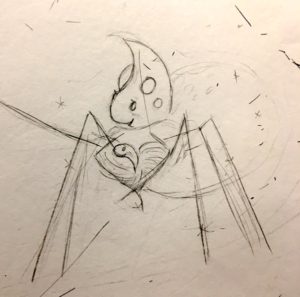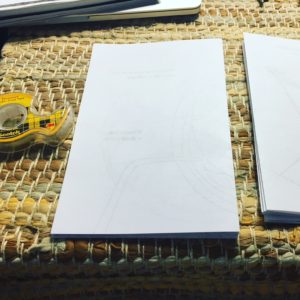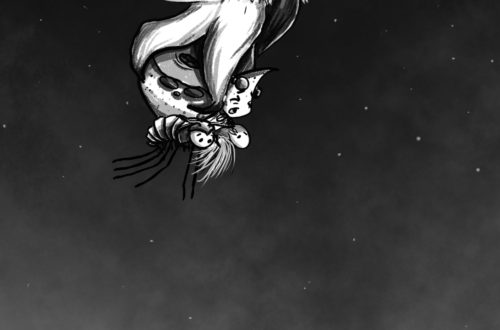
Picture Book in the Works! Process of Making a Book Dummy – Wishweaver

A New Picture Book is in the Works!
I’ve written a new picture book and Book Dummy #5 is now complete.
You may remember that I wrote a picture book late last year called Benny the Bookworm which is an alliterative story in which: Benny LOVES books, but being a worm has its disadvantages. He befriends Beatrice the butterfly to help with the heavy lifting but when Benny pushes Beatrice away to keep the books all to himself, he’ll end up alone in a bind without her there to help him.

While writing Benny’s story, I always had another alliterative tale in mind that could go along in a series. This time around, it was to be about an arachnid. A widow spider named Whimsy.
It was known around Weyburn that should you be in want of a wish, Whimsy was the widow who held them.
And so Whimsy’s story begins.
The name Wishweaver came easily to me, for that is precisely what Whimsy is. I was in love with Whimsy and her story from the minute she made her way into my imagination. So, now her tale has been told in the pages of my book dummy equipped with all of my illustration ideas that could be seen throughout the book (should future art directors so desire).
 The process of creating a picture book for me starts with writing the manuscript. Then once I have that fleshed out enough, I take the words and begin separating the possible page spreads and deciding if the story fits better as a 32-page or 40-page picture book. So far, 40-page has been where my stories have ended up. I attribute that to the fact that I love illustrating and I want to show so much through pictures, 32-pages just doesn’t seem like enough!
The process of creating a picture book for me starts with writing the manuscript. Then once I have that fleshed out enough, I take the words and begin separating the possible page spreads and deciding if the story fits better as a 32-page or 40-page picture book. So far, 40-page has been where my stories have ended up. I attribute that to the fact that I love illustrating and I want to show so much through pictures, 32-pages just doesn’t seem like enough!
 Next up, comes rough…and I mean rough…sketches of each spread. “The messier the better!” is what my instructor from Storyteller Academy, Arree Chung, always says. Though the perfectionist in me finds this difficult, with Wishweaver I gave it a try. As you can see, Whimsy’s look changes from the rough sketches to the more polished illustrations but many of the spread ideas have stayed the same.
Next up, comes rough…and I mean rough…sketches of each spread. “The messier the better!” is what my instructor from Storyteller Academy, Arree Chung, always says. Though the perfectionist in me finds this difficult, with Wishweaver I gave it a try. As you can see, Whimsy’s look changes from the rough sketches to the more polished illustrations but many of the spread ideas have stayed the same.
 Once I finished up all the polished spreads for the book dummy, I went back just yesterday and completed the spreads for the end pages, title/dedication page, and the cover art.
Once I finished up all the polished spreads for the book dummy, I went back just yesterday and completed the spreads for the end pages, title/dedication page, and the cover art.
The process for those is the same: rough sketch to start, pick a favorite, draw a more polished final sketch, and ink it in.

(This next paragraph is a bit technical with the process for making the book dummy hard copy, so you can skip ahead should you wish!)
Once all the sketches are finished and I’ve compiled a PDF through Genius Scan (amazing app to take photos of images/documents and save them together as a PDF), I open the file in Photoshop and overlay the text on each spread. Once everything looks good and all separate images are saved as .PSD and .JPEG files, I go back into Genius Scan and re-upload the documents from Dropbox into a new PDF of the completed dummy. I can email the file to myself and print it off and then tape it all together to make the book dummy as you see it in the pictures above and below.
This story is with my amazing critique group that I found through Storyteller Academy and I hope to have it ready to query alongside Benny the Bookworm very soon.
While I wait for feedback, onto the next project! I need to work on some more illustrations for my portfolio. I am going to be a part of the Portfolio Showcase at the SCBWI LA Conference this year in August. Wish me luck!






6 Comments
David
I’m preparing to query my first author-illustrator work and the picture book dummy part is daunting. I’m using 3D software to render my images, and my process skips the sketching part. Many agent submission guidelines don’t want “finished” artwork in dummies. Is that a disqualifier for agents?
Also, I’ve seen Storyteller Academy recommended from a few other sources in addition to your blog. Have you always worked with them?
JHWinter
Hi David! Thank you so much for reaching out! For the finished artwork, many times, they may ask for one or two finished pieces to include to get an idea of what you have in mind for the final picture book, but that’s not always necessary. I do think it’s helpful to have as a way to show what your vision is for the final picture book if you are planning to illustrate it yourself. The agents will tell you exactly what they want and will want you to follow these instructions to a T. I’ve had agents ask for 1-2 final art pieces while others ask for a link to your portfolio. Still there are others who only want to see the book dummy. It varies so much in this business of querying agents. They each want something different. Some want a summary, others want the full text, it can easily make your head spin. It never hurts to be prepared for whatever they’ll throw at you though! I thoroughly enjoyed Storyteller Academy and found the knowledge I gained there was priceless. I’ve also taken classes through Children’s Book Academy with Dr. Mira Reisberg. It’s helpful if you can find a critique group that will be honest and help you fine-tune your manuscript/illustrations for the book dummy. They’ll help you to craft your query letter as well. As Dr. Reisberg always said, “Take what you like, and leave the rest.” I hope this has been helpful! You can follow my author/illustrator journey over on my new CF Fans page on Creative Fabrica. I’m currently writing and then will be illustrating the third book in my TALES OF WHIMSY series, but plan to also write as I work through my picture books as well. Have a great night!
John Powers
Can a picture book dummy be made on 8 1/2″ x 14″ paper as well as 8 1/2″ x 11″ paper? I have a dummy with the moon as a character, which would be drawn pretty large.
JHWinter
A book dummy can be made on any size really. I even made a pocket dummy once. When you are submitting a book dummy to an agent, however, you need to be able to send them a PDF if they allow attachments. A great app I’m a huge advocate for is called, Genius Scan. It allows you to take a picture of each spread, change the coloring to just black and white (taking out any shadows and whatnot on the paper), snap photos of every spread, and then you can send them to yourself via email. I go in afterwards in Photoshop and add text. That way it’s easy to change as edits are made. Just keep in mind that if you make a longer paper dummy, when you scan it in, there will most likely be more blank space at the top and bottom of the page since the standard paper size is 8 1/2″ x 11″. I hope this is helpful!
Louise Loya Mayne
Thank you! This was VERY informative. Briefly, in 1986 I worked for an Art Agent for Children’s Books, and always wanted to write and illustrate. (Times have changed, I see, in ways to submit a dummy, however, the process is still the same.)
Life interrupted, and so….after 30 years of teaching, and having my illustration degree, I am ready to start, again – in submitting my work.
Any and all suggestions are welcomed! Peace, Louise
JHWinter
Hi, Louise! I’m glad to hear you are going to dive back in to try writing and illustrating your own children’s books! Dummy-making is a fun and trying process. It takes a great deal of patience, love for your characters, and a willingness to toss one idea so another can take its place. Good luck with your creative work, and I will continue to post more about what I’m working on here. If you haven’t already, subscribing to my newsletter will allow me to let you know each and every time there is a new post here. If you have any specific questions, please let me know and I will keep them in mind for future blog posts! 😀